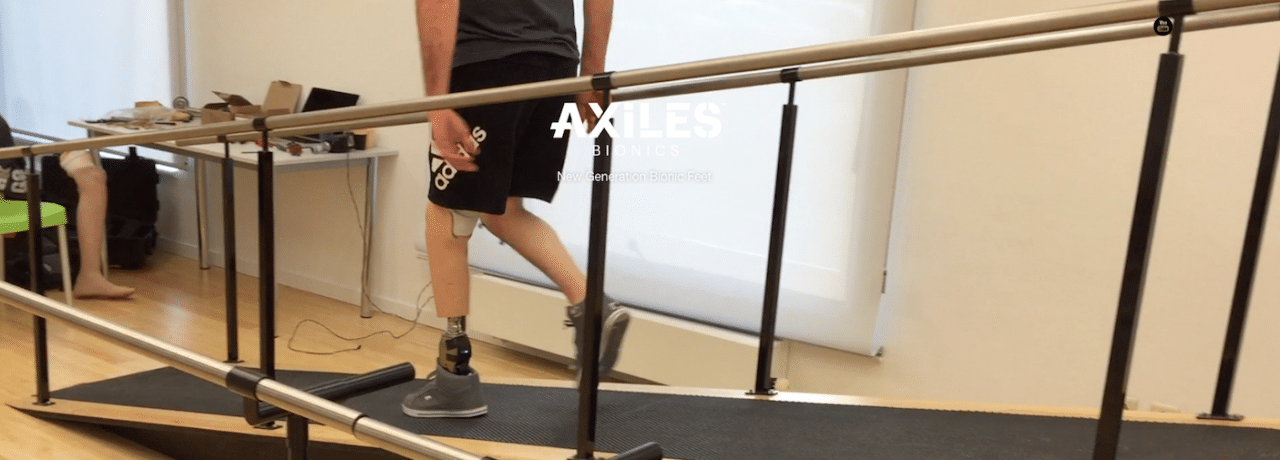
What prompted you to set up Axiles Bionics and what problem did it solve?
“Up until now, people with an amputated foot have had to make do with prosthetics which have no joint functionality. These types of prosthetics don’t function like a real foot does. This causes users pain in their backs, among other things. The current technology for prosthetics was originally developed fifty years ago. It was not until the 1950s that they first made wooden feet that really look like feet. These days, you can see that most prosthetic feet are still made of wood on the inside. We think that we can improve prosthetic feet by adding a joint functionality to them with the aid of robotics. The difficulty is that if you want to restore a joint in the artificial foot, you need to be able to control that joint. That’s what the muscles in the body are for. Robotics can solve this by adding springs and motors that mimic muscle function in the artificial foot. To date, it has not been possible to have the prosthetics perform as finely as a real foot. This is because in order to make certain movements, you have to be able to generate a lot of energy within a short period of time. Motors in the current generation of artificial feet are unable to do that. But with Axiles Bionics, we use springs in combination with a motor in a complex mechanical system that is capable of generating this power. You can compare this method with how a bow and arrow works. By shooting the arrow through the bow, the arrow flies much further than if you would throw the arrow by hand. This is due to its tension. Biomechanical studies show that muscular action in feet works in the same way.”

Interested in reading about more start-ups? Read all of our articles in this series here.
What was the biggest obstacle you have had to overcome?
“The trickiest thing is to mimic the working of the muscles. Throughout the world, several research groups are working on this, but there are still no conclusive results. The human body is incredibly difficult to imitate. It is incredibly complex. The second challenge is that humans basically can live up to 80 years without having to replace ‘parts’. Robot parts wear out very quickly. You have to make sure that they last at least three years. That’s not so easy. The human body heals itself, but a machine cannot. Nor should there be any flaws in the system. It should also be understood that the technology must be affordable. No one can afford it if you make a robot foot for €100,000 that you have to replace every three years. That doesn’t make any sense. In the coming months we will be working on how we can solve this problem in a smart way with our technology.”
What has been the most significant breakthrough so far?
“That was the academic research we did. Back then, we weren’t really planning on bringing a prototype to market. The most difficult part was the decision to set up a company in order to further develop this prototype into a market-ready product. We are going to have to hire people for this and find funding for it, and that is what we have got to do so that we are able to bring this technology onto the market.”
What can we expect from Axiles Bionics in the coming year?
“In the coming months, we will continue to push for more research and development, both within Axiles Bionics and that carried out by our partners as well, such as the research groups for robotics and artificial intelligence at the Vrije Universiteit Brussel. Unity builds strength. We strongly believe in these kinds of collaborations. We are convinced that this will allow us to effectively make progress, both in the field of basic research and in the application of an initial product. We do not just want to present ourselves as a developer of prosthetics. Rather, I see us as a company that specializes in robotics, artificial intelligence and the interaction between humans and robots. Our goal is to improve the quality of life. ”
Where do you want Axiles Bionics to be in five years time? What is your ultimate goal?
“We want to develop a center of excellence in Brussels, together with our collaborative partner Brubotics from the Vrije Universiteit Brussel. We aim to become a pioneer in this new domain, and firmly anchor ourselves in Brussels by doing so.”
What does Axiles Bionics’ innovation do to improve on existing prosthetics?
“By using robotics, we are able to ensure that the artificial foot is state of the art across all levels – in terms of mechanics, electronic control and artificial intelligence. At present, there is not a lot of robotics within prosthetics. We are incorporating joint functionality into artificial feet. It will assist the user instead of placing a burden on them.”
Axiles Bionics is
Axiles Bionics is one of twenty start-ups that the pan-European network RobotUnion nominated in July for a prize of up to €223,000. The following round of this European start-up competition will take place in October.

